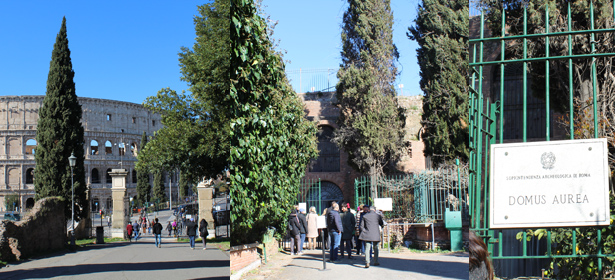
DOMUS AUREA HISTORY
In the early years of his reign, Nerone had built the "Domus Transitional" designed to connect its possessions. During the terrible fire of 64 A.D. the palace burned completely and therefore it was necessary to build a new imperial residence, the Domus Aurea.
The name comes from the Latin, "house of gold". It took this name because of the extensive gold claddings and the ceiling embellished with semi-precious stones and ivory plates requested by the emperator. The villa extended for about 250 hectares, most of the area was occupied by gardens with pavilions destined to parties. At the center of the gardens which included forests and entire vines, there was a pond in part artificial, in which then arose the Colosseum.
Nerone also commissioned a greate big bronze statue of about thirty meters reproducing himself, dressed with the old dress of the Roman sun god, Apollo. The statue was placed at the main entrance of the building, overlooking the Palatine Hill. The statue had been adapted over the years with the heads of the various successors of Nerone, before Adriano decided to demolish it, to build the Flavian Amphitheatre, commonly called Colosseum.
The “Domus Aurea” was essentially a villa for the holidays with approximately three hundred rooms and none of them used as sleeping rooms. The halls were finely coated in fine polychrome marble or richly frescoed. On each floor there were pools and in the hallways fountains..
The fine mosaics were mainly employed for covering floors, but then Nerone decided to decorate mosaic ceilings of some rooms anticipating one of the main issues of Christian art. Today visitors can admire only few fragments of these old mosaics.
It seems that the architects Severus and Celer, designers of the Domus, had created an innovative and ingenious mechanism to ensure the ceiling movement and rotation like the stars in to the sky.
After the Nerone’s death, the palace was stripped of its precious coverings. On the plot of the domus Aurea were built the Baths of Titus, the Temple of Venus in Rome and the Coliseum. In forty years, the Domus Aurea was totally buried under these new constructions.
The burial helped the paintings to survive as sand worked as the volcanic ash of Pompeii, protecting them from moisture.
Towards the end of the XVth century, a young Roman accidentally fell into a cave. The cave was covered with painted figures. Soon the word spread and the young Roman artists lowered themselves down inside the cave to admire the beautiful ancient frescoes. Today the frescoes are faded, but were studied during the Renaissance artists such as Michelangelo and Raphael. Raphael even took inspiration from the frescoes of the Domus Aurea for the making of the Vatican Loggia. Thanks to the discovery of these paintings, the artistic term "grotesque" was created
The Domus Aurea was the subject of a long restoration, the reopening was scheduled for January 2007, but the great monument continued to suffer from the presence of the traffic of the Capital and to the roots of the trees that infiltrated into the ground, creating further instability. For these reasons the restoration is gone very slowly.
On the 30 of March ,2010 collapsed the domus’ entrance vault. This prolonged the long period of closure to the public of the archaeological site, until the year 2015.









